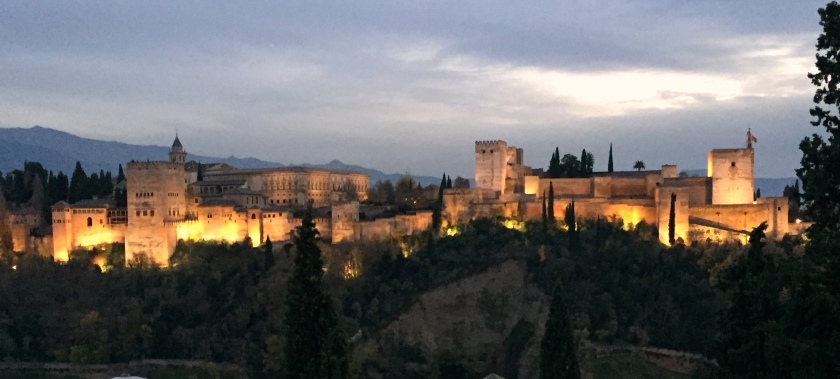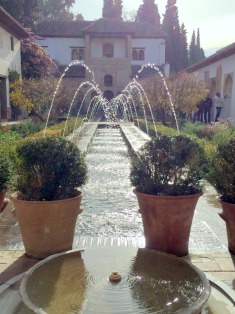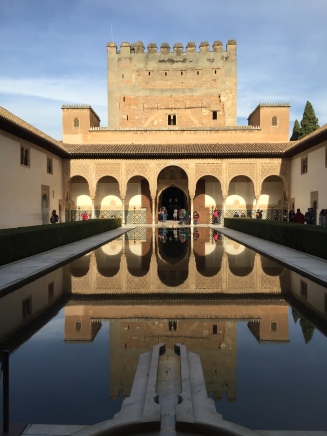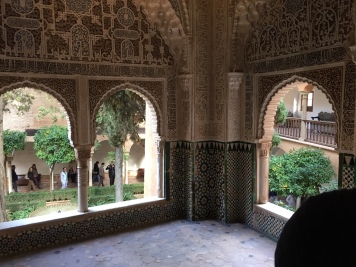Towering over the city of Granada sits the spectacular Alhambra, a once great, self contained, red-walled city with palaces, mosques, and homes. With construction by the Moors beginning in the 9th century, the Alhambra (derived from Arabic meaning the “Red One”) overlooks the Albayzin, a World Heritage Site and the oldest part of Granada. The Alhambra has evolved through the centuries from its original Acazaba fortress (the right side of my photo) to be a seat of Iberian ruling power and authority for Muslim sultans and emirs and Spanish Christian kings and queens.

Today the Alhambra is Granada’s jewel with an average of 10,000 visitors every day. This World Heritage Site has seen numerous notables come and go as well as physical changes over the centuries. In many cases, we can only imagine the Moor’s mosques, schools, houses, baths, gardens, and government buildings. Many structures have disappeared from neglect, war, vandalism, or, as in the case of the mosque, replaced by other buildings such as the Catholic church and another Palace built by Carlos V.

Following the conclusion of the “Reconquest of Spain” from the Moors in 1492, Queen Isabella and King Ferdinand set up a residence at the Alhambra. In the same year Columbus came to the Alhambra to seek financial support for his adventures which was eventually granted as we all know. Napoleon had soldiers quartered within the Alhambra city walls during the Spanish War of Independence. As the troops withdrew in 1812 they blew up several structures thus destroying an important part of the world’s heritage.

The rich Alhambra architecture combines Moorish and Renaissance Spanish with numerous water features and gardens that have been preserved and meticulously restored. The emirs even had their summer palace and rural getaway estate and gardens called “Generalife” which means “Architect’s Garden.” Generalife is adjacent to and outside the Alhambra city walls. It also is a World Heritage Site with its picturesque small park with trees, gardens and several man-made water features on the grounds of a simple-looking palace with many ornate interior wall decorations.
While walking through the grounds I could see how their construction met its objective for providing a calming place for the rulers to relax and unwind from their responsibilities. The park has several very old trees as well as newer plantings which was intended so the park would forever evolve. In the summer vegetables are grown in the Generalife.

In addition to Generalife, the nature themes of plants, water features, and gardens are inside the Alhambra also. All of the water flows naturally through a system of small aqueducts that bring fresh water from the nearby mountains. Water features are everywhere and are important to the Muslims. The plants and trees inside the Alhambra are meticulously maintained. Water is always in the center of each building in courtyards except for those built by the Christians.
In 1492 when the Moors surrendered following a siege of the Alhambra, Ferdinand and Isabella moved into the Alhambra as a residence. Where the sultan once held court, the Spanish monarchs then did in the same room.

The entrance into the residential area of the palace is very ornate. The sultan’s palace rooms are jaw-dropping beautiful as are his “first wife’s” rooms. The sultan’s “first wife” is not numerically determined by marriage date but rather the first with whom he has a male heir. A courtyard with an interesting fountain is between the sultan’s suite and the first wife’s suite. The fountain was given to the sultan 700 years ago by a local Jew and represents the tribes of Israel. The tour guide said that in past ages the relationships between Jews and Muslims were much different than today.

Views of nature are present from each room in the palace. There are numerous walkways through gardens and water features are everywhere. The existing grounds are quite special today and one can imagine what they were like when the Alhambra was a bustling city.
My exploration of the Alhambra was exceptional and there is so much more to see here. Things we learned in school are only a very small part of the exciting (and often sad) history of Spain and the influence that past has for us today. In my blog about the Albayzin district (click here) I describe my exploration of Granada outside of the Alhambra walls where history there also impacts our American way of life.
Here are a few additional photos that I hope you enjoy. The photos are the church built over the Muslim mosque, the ceiling in the sutan’s residence, a walkway through the Generalife retreat, the fountain given to the sultan representing the Tribes of Israel, and the entrance to the Alcazaba fortress.





This is a fascinating place to visit I see. Your night photo was great! The architecture is exquisite. I’m so happy for you that you could see, first-hand, what an amazing place this is!
LikeLike